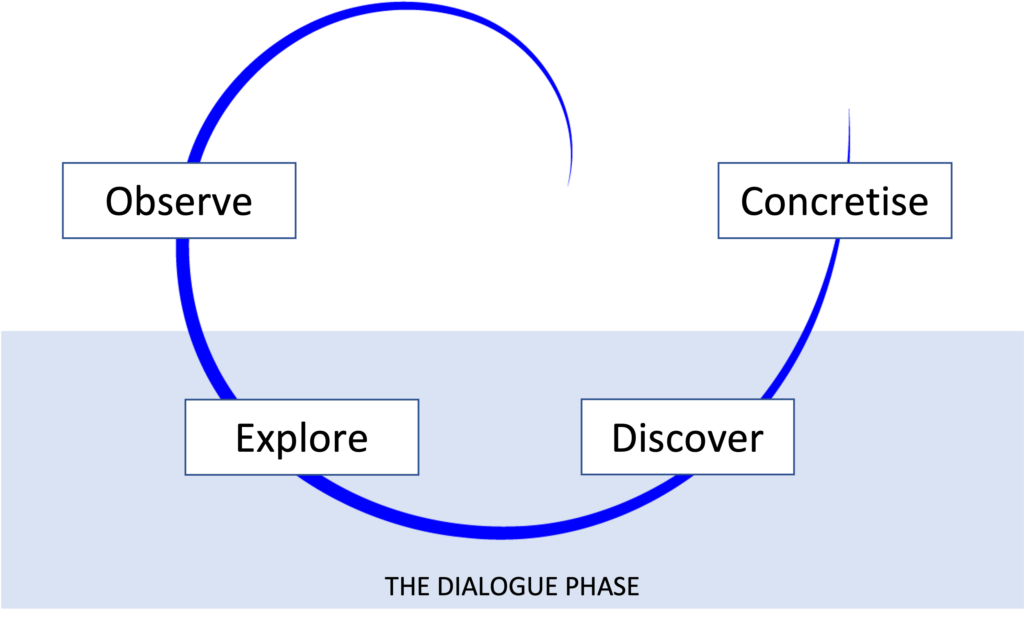A Dialogic Process Logic
A framework for dialogue and dialogic thinking
A Dialogic Framework
The Dialogic Process Logic follows four simple steps and acts as a framework for most situations where dialogue is needed. Its steps are to: observe, explore, discover potential and concretise.
This framework can be applied whenever and wherever dialogue is needed. Generative planning, decision-making, and those involving tension and conflict all benefit from using it, be it for oneself, in relationships and groups, or more extensive processes.

Why the framework is necessary
It is quite natural that we respond to issues by trying to find solutions or answers right away. (In the diagram, this means jumping from Observation straight over to Concretising.) Unfortunately, however, this does not work well when we are dealing with problems that are complex in nature. There is a real risk of missing essential perspectives or excluding important voices.
On the societal level, we often see poor decisions being made to solve problems because the underlying issues have not been addressed. On a group level, we often see how we consider a problem and, due to time constraints, immediately leap into suggesting solutions. The same applies to relationships and interpersonal conversations. We respond quickly to an issue, looking for solutions or even somebody to blame for a problem. On an intrapersonal level, it is also quite common that we immediately look for ways to resolve the challenges we face without taking the time to reflect.
The Dialogic Framework
The dialogic way of resolving problems or making decisions involves refraining from the natural impulse to quickly jump from observation to action and staying with the problem to explore what lies beneath it.
The first phase of the dialogic framework is to observe without judgement or evaluation. One can think of this phase as taking stock of the symptoms.
The second phase involves exploring the causes and effects of the problem. It also involves uncovering underlying thoughts, habits, emotions, values and beliefs.
The third, generative phase, is often a natural outcome of exploring a problem more deeply. In this phase, we ask ourselves: what potential exists for resolving this problem in a more skilful, sustainable way?
In the fourth and final phase, decisions are made, plans are laid out, and responsibility for actions is identified. This is the phase in which ideas are concretised and acted upon.
Applying the framework to ourselves
When making our own decisions, this 4-step process can be helpful. We often react to something somebody says or decide to do something without a second thought. This framework suggests that instead of acting or reacting, we find the “inner pause button” and reflect on what the problem actually consists of. The momentary pause and exploration often lead to the emergence of new possibilities, leading us to make better decisions.
The 4-step dialogic framework also encapsulates the four principles for dialogue: listen (observe), pause your reaction (suspend), respect and speak your truth.
On an interpersonal level
In conversation with other individuals, the 4-step framework can also be followed when dealing with decisions, considering actions or handling problems and conflicts – in short, any dialogue between individuals.
- The first step is to ask: what do we see? what is happening? Can we describe the symptoms?
- The second step involves staying with the issue and enquiring about causes, effects, underlying thoughts, feelings, values and beliefs.
- In the third step, we shift into a creative or generative mode: What is possible? Which connections do we see? Are there any synergies?
- Finally, we need to ask: who takes responsibility for what? Can we take joint responsibility? What needs to be done by whom and when?
The framework on the group level
When working with a group or a team, the 4-step dialogical frame is the same as that described for the interpersonal level. The only difference is that more people are encouraged to participate in each step.
This can be done by dividing the group into smaller buzz groups or keeping the group or team together. We might need to facilitate smaller working groups in organisations and larger groups.
In larger processes
The dialogic process logic can be applied and has proved to be very helpful when planning and executing large processes dealing with societal problems.
- The observation phase can take days, weeks or months, depending on the depth of observation one wants. Here one can consider using interviews or meetings with homogenous stakeholders.
- The exploration phase is usually done with all the stakeholders, following the principle that stakeholders define the (complex) problem together. Of course, one must consider who represents the different stakeholders or perspectives.
- The generative phase follows naturally from the exploration phase, and the two are often linked. In this phase, the stakeholders explore what is possible. Which common interests exist? Which new opportunities emerge?
- The concretisation phase can take different forms. Those participating in this phase are asked: what action is necessary? When and how will the action be taken? How can it be followed up? What can you take responsibility for? What do others need to take responsibility for? What can the group take collective responsibility for?
Such large-scale dialogue processes take time and need to be designed carefully.
Credits
The dialogic 4-step process logic is an adaptation from a linear model based on design thinking used by Dialogues earlier. It is inspired by Rooken Podesta, who has adapted it from Otto Scharmer’s theory-U. It has been helpful in many dialogues on different levels of scale.
